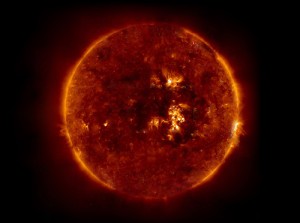The first principle of the The Essential Principles of Climate Sciences states: “The Sun is the primary source of energy for Earth’s climate system.” This broad statement encompasses several underlying concepts (for more information, please see our article The Sun: Earth’s Primary Energy Source. Two of these concepts align with concepts typically addressed in the elementary grades:
- Concept A. Sunlight reaching the Earth can heat the land, ocean, and atmosphere. Some of that sunlight is reflected back to space by the surface, clouds, or ice. Much of the sunlight that reaches Earth is absorbed and warms the planet.
- Concept C. The tilt of Earth’s axis relative to its orbit around the Sun results in predictable changes in the duration of daylight and the amount of sunlight received at any latitude throughout a year. These changes cause the annual cycle of seasons and associated temperature changes.
In keeping with these concepts, we’ve highlighted lessons that help elementary students develop an understanding of how the Sun’s light warms Earth’s air, land, and water and how variation in daylight hours are associated with seasonal change. We’ve also included lessons that provide opportunities for primary students to make observations about the seasons, including weather, behavior, and changes in the plants and animals they see outside. While these observations are not directly related to the concepts described above, they are helpful in building a solid foundation for the understanding of the Sun’s role in the climate system and seasonal change.
Solar Energy
The Warmth of the Sun (Grades K-2)
This introductory lesson helps students understand the sun’s role in heating and warming earth’s air, land, and water. Through indoor and outdoor activities, students will make qualitative approximations of heat and will gain a basic understanding of the concepts surrounding the sun’s heat energy. This lesson meets the National Science Education Standards: Science as Inquiry Content Standard, Physical Science Content Standard, and Earth and Space Science Content Standard.
Cooler in the Shadows (Grades K-2)
In this lesson, students will make inferences about the cause of shadows by observing and making their own shadows in the sun. Many properties of shadows (such as heat and brightness of light) will also be identified firsthand as students conduct a number of simple experiments over a four-day period. This lesson meets the National Science Education Standards: Science as Inquiry Content Standard, Physical Science Content Standard, and Earth and Space Science Content Standard.
Our Super Star (Grades K-5)
A multiday lesson plan about the sun. Part III, in which students create solar ovens to cook s’mores, is most relevant to our topic, solar energy. A related resource is the Cooking Cookies with Solar Power QuickTime video, which tests two homemade solar cookers. This lesson meets the National Science Education Standards: Science as Inquiry Content Standard, Physical Science Content Standard, and Earth and Space Science Content Standard.
Light Absorption (Grades K-2 with modifications)
Students investigate how color affects absorption and temperature by creating pockets of black and white construction paper. While the plan is designed for students in grades 5-9, teachers can use the basic activity with a whole class in the primary grades. This lesson meets the National Science Education Standards: Science as Inquiry Content Standard, Physical Science Content Standard, and Earth and Space Science Content Standard.
Investigating Radiation (Grades 3-5 with modifications)
In this lesson, students investigate how different surfaces absorb heat. The lesson is designed for grades 5-9, but the experimental set-up can easily be used with upper-elementary students. Needed modifications may include holding a class discussion instead of having students answer the questions independently and in writing. The lesson also provides the opportunity for students to design and test their own materials. This lesson meets the National Science Education Standards: Science as Inquiry Content Standard, Physical Science Content Standard, and Earth and Space Science Content Standard.
NAEP Assessment Item: White clothes in hot weather (Grades 3-5)
Students are asked to explain why people choose to wear white clothes in hot weather after examining a picture of two buckets of water that have sat outside on a hot, sunny day. The picture includes the buckets of water with thermometers in them both before sitting in the sun and after sitting in the sun. This constructed response question is a sample test item used in past National Assessments of Educational Progress (see About NAEP). The URL link above takes the user to the NAEP test item, with access to performance data by various subgroups, a scoring guide and student responses, and the content on which the item is based. The NAEP web site allows users to build their own printable database of test items by clicking on Add Question in the upper right hand corner of the screen. NAEP Reference Number: 2000-4S12 No.:11
Teachers might use this item as an assessment for the Light Absorption or Investigating Radiation lesson described above. The question could also be used as the basis for a hands-on investigation of the absorption and reflection of light. This assessment item aligns with the Physical Science Content Standard of the National Science Education Standards.
Seasonal Change
Outdoor Observation (Grades preK-2)
Students use their five senses to observe the seasons and communicate their observations through drawing and conversation. This lesson meets the National Science Education Standards Science as Inquiry content standard and Earth and Space Science content standard for grades K-4.
Seasons (Grades preK-1)
Students will create a class chart showing what they are wearing. They will also become “season watchers” to help them understand the seasons. Integrated literacy activities include reading trade books, writing acrostic poems, and creating a class book about the seasons. This lesson meets the National Science Education Standards Science as Inquiry content standard and Earth and Space Science content standard for grades K-4.
Astronomy with a Stick (Grades 3-5)
Astronomy with a Stick, or AWS, is a series of three units that address this question: Why do daylight hours vary in length where we live? To answer this question, students make indirect observations of the Sun on the school playground and with models built in the classroom. Students keep journals, graph data, and discuss findings with peers and as a class. These units meet the National Science Education Standards Science as Inquiry content standard and the Earth and Space Science content standard.
Journey North: Mystery Class (Grades 4-5)
Mystery Class is a collaborative activity for students in grade 4 and up. In this 11-week program, students use clues – sunrise and sunset times from 10 mystery locations – and similar data from their hometown to determine the locations of the mystery classes. The program usually runs from January to May.
Even if you aren’t participating in Mystery Class this year, you’ll find many teaching resources on the site. The Build Understanding section of the index page contains optional lessons to help students understand earth’s seasonal and daily cycles, practice using latitude and longitude, and graph photoperiods. In addition to traditional lesson plans, interactive slide shows allow students to visualize the entire earth both daily and seasonally. Assessment ideas, checklists, and a student journal are included on the web site as well. These lessons meet the National Science Education Standards Science as Inquiry content standard and the Earth and Space Science content standard.
This article was written by Jessica Fries-Gaither. Jessica is an education resource specialist at The Ohio State University and project director of Beyond Penguins and Polar Bears. She has taught in elementary and middle school settings. Email Jessica at beyondweather@msteacher.org.
Copyright February 2011 – The Ohio State University. This material is based upon work supported by the National Science Foundation under Grant No. 1034922. Any opinions, findings, and conclusions or recommendations expressed in this material are those of the author(s) and do not necessarily reflect the views of the National Science Foundation. This work is licensed under an Attribution-ShareAlike 3.0 Unported Creative Commons license.





